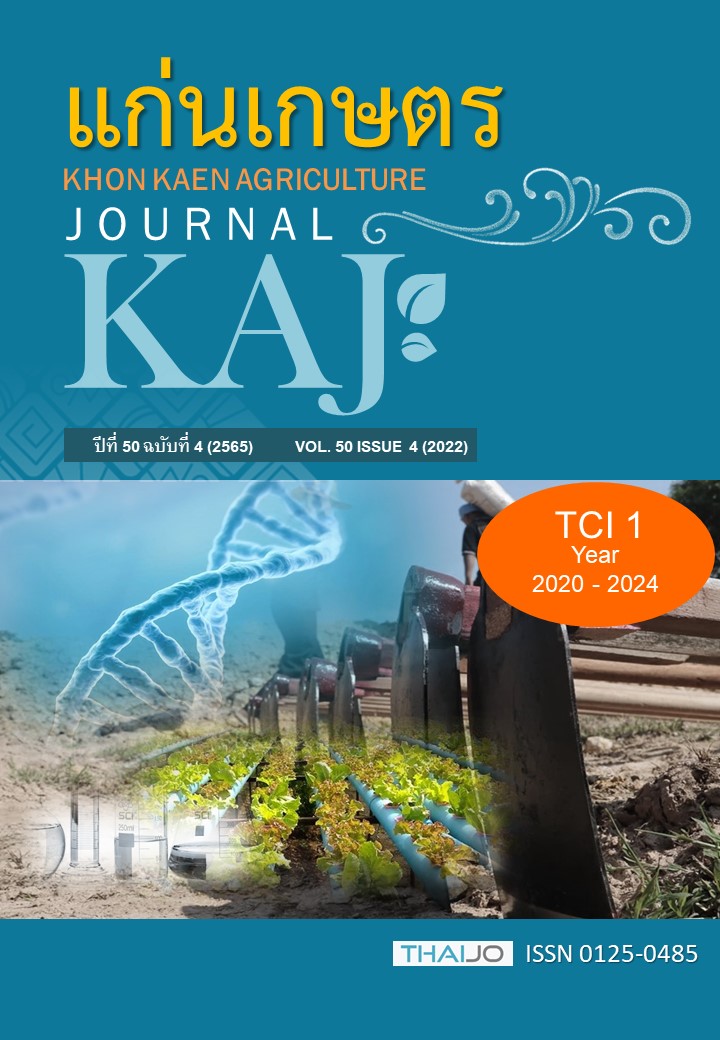ผลของการเสริมใบบัวบกผงในอาหารต่อผลผลิตไข่และค่าโลหิตวิทยาในนกกระทาญี่ปุ่น
Main Article Content
บทคัดย่อ
การศึกษาในครั้งนี้มีวัตถุประสงค์เพื่อศึกษาผลของการเสริมใบบัวบกผงในอาหารต่อผลผลิตไข่และค่าโลหิตวิทยาในนกกระทาญี่ปุ่น วางแผนการทดลองแบบสุ่มสมบูรณ์ ใช้นกกระทาญี่ปุ่นจำนวน 360 ตัว อายุ 84 วัน แบ่งการทดลองออกเป็น 4 กลุ่ม กลุ่มละ 3 ซ้ำ ซ้ำละ 30 ตัว คำนวนสูตรอาหารที่มีการเสริมใบบัวบกผงที่ระดับ 0, 2, 4 และ 6% ในสูตรอาหาร ที่มีระดับโปรตีน 20% และพลังงานใช้ประโยชน์ได้ 2,800 kcal/kg ทำการบันทึกข้อมูลน้ำหนักตัว จำนวนนกตาย ปริมาณอาหารที่กิน ผลผลิตไข่ และคุณภาพไข่ เก็บตัวอย่างเลือดและวิเคราะห์ค่าโลหิตวิทยา ผลจากการทดลองพบว่าการเสริมใบบัวบกผงมีผลต่อปริมาณอาหารที่กินและอัตราการเปลี่ยนอาหารเป็นน้ำหนักไข่ 1 กิโลกรัม (P<0.01) แต่ไม่มีผลต่อน้ำหนักตัว (P>0.05) การเสริมใบบัวบกผงไม่มีผลทำให้ผลผลิตไข่ น้ำหนักฟองไข่ มวลไข่ เปอร์เซ็นต์เปลือกไข่ เปอร์เซ็นต์ไข่แดง และความหนาเปลือกไข่แตกต่างกัน (P>0.05) แต่มีผลทำให้เปอร์เซ็นต์ไข่ขาว และคะแนนสีของไข่แดงแตกต่างกัน การเสริมใบบัวบกผงมีผลทำให้สีของไข่แดงเพิ่มขึ้นอย่างมีนัยสำคัญทางสถิติ (P<0.05) การเสริมใบบัวบกผงสามารถลดค่าน้ำตาลในเลือด ไตรกลีเซอไรด์ คอเลสเตอรอล และ LDL (Low Density Lipoprotein) ในเลือดนกกระทา ผลการวิจัยชี้ให้เห็นว่าการเสริมใบบัวบก 2% ในสูตรอาหารนกกระทาสามารถช่วยเพิ่มประสิทธิภาพการผลิตโดยรวมโดยไม่ก่อให้เกิดผลเสียต่อสุขภาพของนกกระทา
Article Details

อนุญาตภายใต้เงื่อนไข Creative Commons Attribution-NonCommercial-NoDerivatives 4.0 International License.
เอกสารอ้างอิง
ตรีรัตน์ สายวรรณ์, ประภาศรี ภูวเสถียร, อังคารศิริ ดีอ่วม, และครรชิต จุดประสงค์. 2558. คุณค่าทางโภชนาการของไข่ที่นิยมบริโภคและผลของการประกอบอาหาร. วารสารวิทยาศาสตร์และเทคโนโลยี. 23(4): 651-666.
ทัศนีย์ อภิชาติสรางกุล. 2552. การใช้กากเหลือจากการสกัดใบบัวบกในการผลิตอาหารไก่เนื้อเพื่อทดแทนยาปฏิชีวนะ. สถาบันวิจัยวิทยาศาสตร์และเทคโนโลยี มหาวิทยาลัยเชียงใหม่. แหล่งข้อมูล: https://archive.lib.cmu.ac.th/full/res/2552/tressct530152_52_full.pdf. ค้นเมื่อ 16 มีนาคม 2564.
บุคอรี มะตูแก, ซาแลฮะห์ หะยีสา, และนูรซอบารียะห์ แกะซิ. 2563. ผลของการใช้น้ำหมักสมุนไพรไทยต่อสมรรถภาพการผลิตและคุณภาพไข่นกกระทาญี่ปุ่น. วารสารวิทยาศาสตร์และเทคโนโลยี มรย. 5(2): 78-84.
พัชนีนาฏ สุวานิช. 2546. ผลของการใช้บัวบกในอาหารไก่กระทงต่อสมรรถภาพการผลิต ระดับภูมิคุ้มกัน และคุณภาพเนื้อ. วิทยานิพนธ์ปริญญาวิทยาศาสตร มหาบัณฑิต. มหาวิทยาลัยเชียงใหม่. เชียงใหม่.
Abdou, H. M., and A. M. Nema. 2016. Centella asiatica Ameliorates diabetic complications and oxidative stress in streptozotocin-induced diabetes mellitus in male rats. International Journal of Pharmaceutical Sciences Review and Research. 36(2): 61-70.
Abou-Elezz, F.M.K., L. Sarmiento-Franco, R. Santos-Ricalde, and F. Solorio-Sanchez. 2011. Nutritional effects of dietary inclusion of Leucaena leucocephala and Moringa oleifera leaf meal on Rhode Island Red hens’ performance, Cuban Journal of Agricultural Science. 45: 163-169.
Ajayi, O.A., M.D. Olumide, G.O. Tayo, and A. O. Akintunde. 2020. Evaluation of chemical and elemental constituents of Centella asiatica leaf meal. African Journal of Agricultural Research. 16(5): 661-666.
Alagbe, J.O. 2019. Effects of dried Centella Asiatica leaf meal as a herbal feed additive on the growth performance, heamatology and serum biochemistry of broiler chicken. International Journal of Advanced Biological and Biomedical Research. 7(3): 225-236.
Al-Qazzaz, M.F.A., D. Ismail, H. Akit, and L. H. Idris. 2016. Effect of using insect larvae meal as a complete protein source on quality and productivity characteristics of laying hens. Revista Brasileira de Zootecnia. 45: 518-523.
AOAC. 2000. Official methods of analysis. Association of official analytical chemist (17thed). Gaitherburg, Maryland, U.S.A.
Chandrika, U. G., A. A. S. Peramune, and P. Kumara. 2015. Chapter four - Gotu Kola (Centella asiatica): nutritional properties and plausible health benefits. Advances in Food and Nutrition Research. 76: 125-157.
Gohil, K.J., J.A. Patel, and A.K. Gajjar. 2010. Pharmacological review on Centella asiatica: A potential herbal cure-all. Indian Journal of Pharmaceutical Sciences. 72(5): 546–556.
Hussin, M., A. A. Hamid, S. Mohamad, N. Saari, F. Bakar, and S.P. DEK. 2009. Modulation of lipid metabolism by Centella Asiatica in oxidative stress rats. Journal of Food Science. 74(2): 72-78.
Masadah, S. M., S. Sunarno, and M. Djaelani. 2019. Application of cinnamon and gotu kola supplements for increasing quail hematological status (Coturnixcoturnix-australica). Journal of Physics: Conference Series. 1217: 1-9.
Mudzwiri, M. 2007. Evaluation of traditional South African leafy plants for their safety in human consumption. M. S. Thesis. Durban University of Technology, Durban, South Africa.
NRC. 1994. Nutrient Requirements of Poultry. 9th ed. National Academy Press, Washington DC.
Nurfianti, A., and Y. A. Tribudi. 2016. Malondialdehyde (MDA) and cholesterol in Quail eggs with feed addition pegagan flour (Centella asiatika). Jurnal Teknologi Pertanian. 17(3): 187-1940.
Ogunka-Nnoka, C.U., F.U. Igwe, J. Agwu, O.J. Peter, and P.H. Wolugbom. 2020. Nutrient and Phytochemical Composition of Centella asiatica Leaves. Medicinal and Aromatic Plants. 9(2): 346-352.
Rastog, R.P., B. Sarkar, and M.L. Dhar. 1960. Chemical examination of Centella asiatica Linn. I, Isolation and the chemical constituents. Journal of Scientific and Industrial Research. 19: 252-257.
Saleh, A., A.D. Ijiri, and A. Ohtsuka. 2014. Effects of summer shield supplementation on growth performance, nutrient utilisation, and plasma lipid profiles in broiler chickens. veterinary medicine journal. 59(11): 536-542.
SAS. 1996. SAS/STAT Software Release. 6.12. SAS Institute Inc., Cary. NC.
Steel, R.G.D., and J.H. Torrie. 1992. Principles and Procedure Statistics. 2 nd Edn. McGrew-Hill Book Co., Inc. Singapore.
Supkamonseni, N., A. Thinkratok, D. Meksuriyen, and R. Srisawat. 2014. Hypolipidemic and hypoglycemic effects of Centella asiatica (L.) extract in vitro and in vivo. Indian Journal of Experimental Biology. 52: 965-971.
Zhang, M., N. S. Hettiarachchy, R. Horax, A. Kannan, A. Praisoody, A. Muhundan, and C.R. Mallangi. 2011. Phytochemicals, antioxidant and antimicrobial activity of Hibiscus sabdariffa, Centella asiatica, Moringa oleifera and Murraya koenigii leaves. Journal of Medicinal Plants Research. 5(30): 6672-6680.


